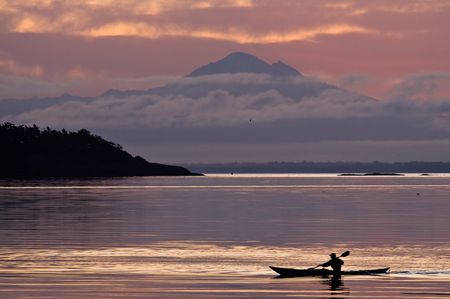
After realizing the gaping hole between my convictions about climate change and my own carbon footprint, I embarked on a yearlong experiment in 2008 torediscover the heart of where I live, by the shores of Puget Sound. I traded in my car and jet travel for a kayak, a bicycle, and my own two feet, exploringa radius of 100 kilometers from my home. I chronicled my travels in . In the spirit of that adventure, I offer here my top ten list of what to do for Earth Day, in light of the what I learned “homecoming” can mean in an era of deep ecological disruption.
–Kurt Hoelting
10. Make a 500-year and a 10,000-year plan for the restoration ofyour home territory: Think about who will be here generations after you are gone.What shifts are needed now in the way you live thatwill prepare the way for deep restoration far beyond yourown life span? Begin changing your behavior as if the very future of life on earth depends on whateach one of us decides to do now–which, in fact, it does.
9. Don’t limit your Earth Day explorations to scenic vistas: Take a peek into the ravaged places nearhome, too. Understand our shared complicity in these losses, but don't get mad and start pointing fingers. Think about what willit take to restore this place, and commit yourself to a specific act, like joining a local ecological restoration group. You may not see immediate results, but every action counts.
8. Dig deep into the cultural history of your home ground:Which ancient, native tribes lived near your home, and how did they live? What specific places were important to them andwhy? What local tribes are still there? Try visiting theircommunities and taking part in their celebrations. You'll get to know their relationship with the land, and more about the land itself.
7. Make a list of vacations you could take close to home: If you travel a lot by jet, plan to trade in ahigh-carbon vacation this year for a low-carbon alternative. See it as an opportunity rather than a sacrifice. Knowthat a single jet flight to Asia or Europe from the U.S.produces the equivalent carbon emissions per passenger as driving anSUV for several months. Is your trip worth this cost to the planet? Where could you explore back homethat might be just as compelling, without all the hassle and expense of jet travel?

5. Know your carbon footprint: Take a carbon footprint survey online. See how your footprint compares with the national average. Learn in detail where your use of energy is excessive, and commit yourself to taking concrete steps to cut back. Make a plan and a specific timeline for making those changes.
4. Take a child into nature: We live in an era of childhood obesity and “nature-deficit disorder.” Taking a child into nature will open up the universe to that child. Let them lead you as they explore, and go at their pace. Seethrough their eyes, and you'll find adventure.
3. Spend the entire day uncoupled from mechanized travel: Your ancestors didn't have all our modern contraptions–you can learn something from them. What did they know by living closer to theearth that you are in danger of forgetting? Indulge in the simplepleasures of walking, sitting still, and listening. Get back to a directexperience of the natural world.
2. Celebrate Earth Day with someone you love: The pleasure you take inthe company of a loved one is an expression of your own inner wildness.It may be the single greatest act of inner habitat restoration that you can accomplish on Earth Day.
1. Explore locally: Rediscover the variety and wonder of what is nearat hand. Get a detailed map of your home territory and find ten placeswithin ten miles of home that you’ve never explored. Choose one,and take an Earth Day field trip there. Travel on foot or bike. You could be astonished by what youfind.
Photo at top by Dan Kowalski